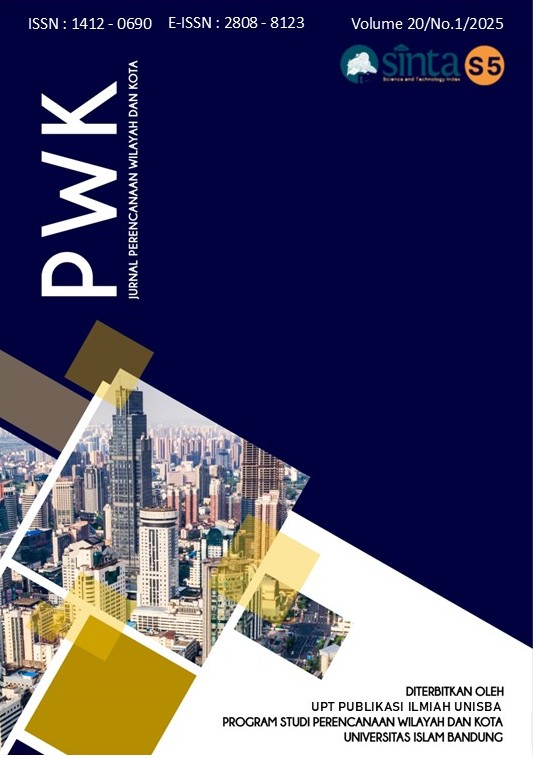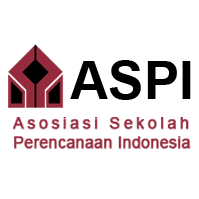Determining the Location of Public Green Open Space (Case Study: Soreang Urban Area)
Determining the Location of Public Green Open Space (Case Study: Soreang Urban Area)
DOI:
https://doi.org/10.29313/jpwk.v20i1.4247Keywords:
Green Open Space, Land Tenure, Population, Service Coverage, Urban Heat IslandAbstract
The increasing urban population will have an impact on the declining quality of the environment. These problems include high air pollution, flooding, and decreased community productivity due to stress caused by limited social interaction space. This needs to be suppressed by the presence of green open spaces (RTH) where RTH is the lungs of the city, microclimate regulators, shade, oxygen producers, rainwater absorbers, animal habitat providers and others. However, RTH only lowers the temperature in the surrounding area and does not lower the temperature of the entire urban area. In addition, RTH has a limited service range. Seeing this phenomenon, there needs to be an explanation why the location of RTH must be one stretch or preferably partial/spread so that in its implementation it is right on target according to needs. This study uses a social and environmental approach. The social approach uses the variables of population and land/land ownership. The environmental approach uses the Urban Heat Island variable and the range of RTH services. These variables are then analyzed spatially using arcgis software. Based on the UHI variables, the range of RTH services, the location of built-up land, the results of the study show that in order for the benefits of RTH to be maximized, in determining the location of RTH, the location of RTH should be partial/spread and not one stretch.
References
Achsan, A. C. (2009). Perencanaan Ruang Terbuka Hijau Kota Bogor dengan Menggunakan Pendekatan Sistem Dinamik. Institut Pertanian Bogor.
Adiyanta, F. C. S. (2018). Urgensi Ketersediaan Ruang Terbuka Hijau sebagai Ruang Publik dalam Tata Kota Berwawasan Lingkungan Hidup. Gema Keadilan, 5(1), 52.
Anggriani, N. (2010). Ruang Publik dalam Perancangan Kota (1st ed.). Surabaya: Yayasan Humaniora.
Arifah, N., & Susetyo, C. (2018). Penentuan Prioritas Ruang Terbuka Hijau berdasarkan Efek Urban Heat Island di Wilayah Surabaya Timur. Jurnal Teknik ITS, 7(2).
Caesarina, H. M., & Saubari, N. (2019). Peran Ruang Terbuka Hijau Dalam Perencanaan Kota Sebagai Potensi Pembentuk Smart City. Jurnal Teknik Lingkungan, 5(1), 28–39.
Humaida, N. (2016). Metode penentuan prioritas ruang terbuka hijau di kota banjarbaru kalimantan selatan nida humaida. Institut Pertanian Bogor.
Jamaludin, A. N. (2015). Sosiologi Perkotaan. In Sosiologi Perkotaan (2nd ed.). Bandung: CV Pustaka Setia.
Judiantono, T. (2016). The Challenge of Rural-Urban Development in The Shape of Sustainable Land Transportation in Indonesia. (RRPG 7th International Conference and Field Study in Malaysia 2018).
Kompas.com. (2012). Hampir 54 Persen Penduduk Indonesia Tinggal di Kota. Retrieved November 10, 2020, from https://nasional.kompas.com/read/2012/08/23/21232065/ Hampir.54
Noviyanti, I. K. (2019). Pengaruh Ketersediaan, Aksesibilitas, dan Penggunaan Ruang Terbuka Hijau Terhadap Jumlah Kasus Penyakit Spesifik di Kota Yogyakarta. Universitas Gadjah Mada.
Peraturan Daerah Kabupaten Bandung. Peraturan Daerah Kabupaten Bandung Nomor 27 Tahun 2016 tentang Rencana Tata Ruang Wilayah Kabupaten Bandung Tahun 2016 - 2036. , (2016).
Peraturan Menteri Agraria dan Tata Ruang/Kepala Badan Pertanahan Nasional. Peraturan Menteri Agraria dan Tata Ruang/Kepala Badan Pertanahan Nasional Nomor 14 Tahun 2022 tentang Penyediaan dan Pemanfaatan Ruang Terbuka Hijau. , (2022).
Peraturan Menteri Pekerjaan Umum. Peraturan Menteri Pekerjaan Umum Nomor 05/PRT/M/2008 Tentang Pedoman Penyediaan dan Pemanfaatan Ruang Terbuka Hijau di Kawasan Perkotaan. , (2008).
Rasjiddin, A. I. (2020). Model Efek Pendingin Suhu Ruang Terbuka Hijau Publik Studi Kasus DKI Jakarta. Institut Tinggi Bandung.
Thompson, C. W., & Bell, P. A. and S. (Eds.). (2010). Innovative Approaches to Researching Landscape and Health. London and New York: Routledge.
Worldometers.info. (2020). Indonesia Demographics 2020 (Population, Age, Sex, Trends) - Worldometer. Retrieved November 10, 2020, from https://www.worldometers.info/demographics/indonesia-demographics/#urb
Downloads
Published
How to Cite
Issue
Section
License
Copyright (c) 2025 Muhammad Arief Setiawan, Tonny Judiantono, Saraswati

This work is licensed under a Creative Commons Attribution-ShareAlike 4.0 International License.















